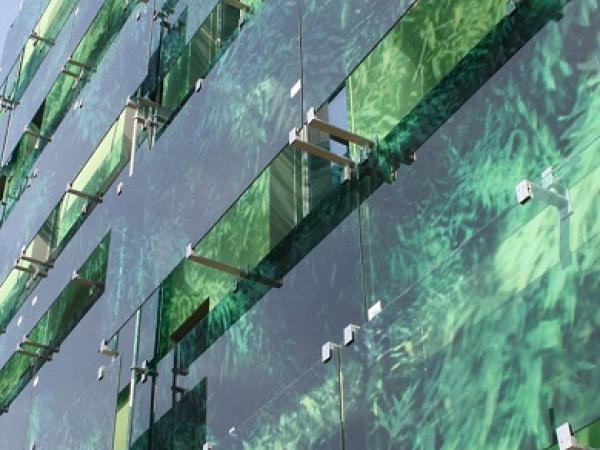The sleek and often complex profiles of modern buildings offer limited decorative possibilities, both on exterior facades and in interiors. Today, however, there is a practical way to overcome the ‘sameness’ of today’s architecture: patented Numericoat® technology from professional coating innovators and image management company Visio-Technic.
Innovation in architectural decor
Visio-Technic Numericoat is an innovative synthesis of digital print and industrial surface coatings, and it delivers an advanced professional solution for the creation of customised, durable, architectural graphics, signs, displays, images, and colours on a variety of today’s building construction materials.
‘Starting with a standard plain substrate – metal, glass, or composite’, explains Visio-Technic’s Commercial and Marketing Director, Martin Saunier-Plumaz, ‘our in-house production team take a digitally-generated image of the customer’s choice, and capture it on the substrate within Numericoat’s two special layers of spray-applied thermo-hardening primers.
The Numericoat base layer provides the anchorage for the flatbed inkjet-printed image, and the top overlamination coat gives it perfect protection. Not only is it fire- and UV-resistant, it also has anti-graffiti functionality.’
Guaranteed durability
‘Perhaps most important of all for the construction industry, Numericoat panels come with a ten-year durability guarantee – true confirmation that this is genuinely a highly-durable solution’, says Mr. Saunier-Plumaz.
Versatile image production
The versatility of the flatbed inkjet’s movable printhead makes it practical to print on to very large panels – up to 6.5 metres long and 2 metres wide – using UV-cured acrylic inks to deliver a high-definition four-colour CMYK printed image.
.jpg)
The proven benefits of UV inks
UV inks deliver benefits at various levels, as Mr. Saunier-Plumaz explains. ‘They dry very quickly at ambient pressure – in seconds, rather than the 30 minutes it takes at 200ºC for traditional solvent-based inks, lowering the production costs. UV inks also offer good flexibility and good adhesion to the substrate. That makes shipping the panels easier, and makes it possible for our clients to cut and bend (if necessary) the coated panels at the application site. And of course UV inks’ environmental credentials are excellent – low odour, no solvents, reduced energy usage. That’s important.’
RadTech Europe Innovation Award
In fact, Numericoat’s creative use of UV inks gained Visio-Technic the prestigious Innovation Award in the 2013 RadTech Europe Awards, presented biennially by the European Association for UV/EB Curing Technology.
A global commercial reality
‘Numericoat is not an experimental technique’, says Mr. Saunier-Plumaz. ‘We worked on its development at Visio-Technic for many years, and commercialised it eight years ago. Since then, the system has proved itself in an enormous variety of applications, from corporate company headquarters to theme parks, sports arenas, factories, and outdoor and indoor frescos.’
Quality, suitability, and durability -- certified
Formally partnered since 2011 by steel giant ArcelorMittal, who now market Numericoat products under their Viso brand, across their global network, Numericoat is Qualicoat licensed for homogeneity with aluminium varnishes and coatings, and certified to the ISO9001 quality standard and to the EOTA ETAG 002 agreement for adhesive exterior window systems. It is RATP M1 fire-resistant.
UV and EB radiation curing
UV and EB radiation curing are today well known processing technologies in many industrial segments such as wood and metal product finishing, packaging, and automotive components, as well as in graphic imaging applications.
David Helsby, President of RadTech Europe, says that this wide acceptance is ‘testimony to the robust nature of the cure that can be achieved, as well as the elimination of VOC emissions, significant reductions in energy consumption, and of course time- and cost-savings.’ In printing and graphic arts applications, he adds, ‘UV curing’s faster on-press turn-around coupled with excellent ink adhesion to the print substrate are high-profile field of continuing innovation today, with traditional high-energy lamps beginning to be replaced with “cold” UV LED lamp arrays on leading-edge high-speed printing presses. Visio-Technic’s Innovation Award for Numericoat highlights another new step on the ladder for radiation curing.’
About RadTech
RadTech Europe (RTE), founded in 1988 in Switzerland and headquartered in The Hague (The Netherlands), is the European industry association that promotes the development, use and benefits of UV/EB curing technology for the markets of Graphic arts, Adhesives, Electronics, Industrial Coatings, Automotive, Medical, Dental, Cosmetics and an array of new emerging applications. RTE membership provides access to a collaborative platform, for knowledge transfer at educational, and networking events and achieves effective representation as a body in public affairs initiatives. www.radtech-europe.com
About Visio-Technic
Visio-Technic is headquartered in France at Sassenage, near Grenoble. As the company’s Numericoat business continues to grow, fine examples of the results which can be achieved with the technology can now be seen not only in France, but also Switzerland, Belgium, Germany, Poland, Croatia, Slovakia, South Africa, and UAE. www.visio-technic.com.
For more information contact:
duomedia
Lut Verschueren
Tel. + 32 474 04 49 40 - lut.v@duomedia.com
RadTech Europe
Elke Verbaarschot/Mark Macaré
Tel. + 31 703123920 - mail@radtech-europe.com


.jpg)
.jpg)



















